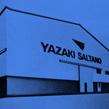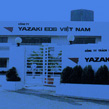Ceremony marking the opening of Thai Yazaki Electric Wire (1962)
Episodes in Yazaki’s global expansion
In this section, see various episodes in Yazaki’s
global expansion at a time when few Japanese companies did business overseas.
HOME Episodes in Yazaki’s global expansion Yazaki’s arrow mark makes its appearance in Gaia, Portugal.

1986 PORTUGAL
Yazaki’s arrow mark makes its appearance in Gaia, Portugal.

Yazaki’s first European production base opens in Portugal.
In the 1980s, the wave of globalization began having a sudden effect on Japan’s automobile industry. Already, Yazaki had quickly and successfully pushed its expansion overseas, beginning with the establishment of Thai Yazaki Electric Wire in 1962 and continuing with American Yazaki Corporation in Chicago in 1966 and Yazaki Oerlikon Corporation, its first sales base in Europe, the following year in 1967. The next objective was now the construction of its first factory in Europe.
In 1985, Yazaki established a European preparatory office. There, with the help of the Yazaki representative stationed in London, three employees began a Europe-wide study to identify the best location for a factory. After eyeing all conditions and considerations, the office finally determined that Portugal offered the best opportunity, and as a result Yazaki’s arrow mark was planted in Portugal, marking the spot of the company’s first European production base.
An Awa Odori dance performance in Gaia
On July 30, 1986, Yazaki Saltano de Portugal Components Electricos Automoveis, Lda. (YSP) was established through a joint venture with Salvador Caetano of Portugal (60% owned by Yazaki, 40% by Caetano). The then head of the preparatory office was named president of the new company.
During the search for a site to build the factory, the company rented a vehicle inspection shop, painted the blackened floors, and used it as a training site for 50 locally hired employees. At the same time, it brought in equipment and materials for the new factory from Japan.
Eventually a 48,000-m2 factory was completed in the town of Gaia. The training period was also completed, and on October 9, 1989, a grand completion ceremony was held for the YSP Gaia Factory. Invited were VIPs from political and financial circles, including Portuguese Prime Minister (now President) Aníbal Cavaco Silva. As a special attraction, more than 20 members of the Tokyo Koenji Awa-Odori Association, brought in from Tokyo at the invitation of President (now Chairman) Yasuhiko Yazaki, put on a rousing dance performance that had the entire venue buzzing.
Unfortunately, production did not proceed as planned for the first three years after startup. Consequently, the staff, including Japanese employees who were posted to Portugal from Japan, spent all their days and nights at the factory. YSP’s chairman at the time later recalled that the hardest part was when the wives of posted workers complained, “My child never sees his father’s face. At least give him Sunday off so he can spend time with his family.”
Upon entering the fourth year, employees began quickly gaining proficiency in their work, which helped get production on track. This led to a sudden improvement in the factory’s balance sheet.
EPISODE SELECTION
EPISODE 01 Yazaki takes its first step overseas to Thailand before the Tokyo Olympics.
EPISODE 03 American Yazaki steps forward at a time when “Made in Japan” had a poor reputation.
EPISODE 04 Yazaki is the first to enter the European market! Offense is the best defense.
EPISODE 06 Yazaki’s arrow mark makes its appearance in Gaia, Portugal.
EPISODE 07 Demonstrate and then let others take over: The Yazaki Way takes root in Vietnam.
EPISODE SELECTION















